

Pulser-Sampler Press Release
ARRAYABLE SAMPLER PULSER CIRCUITS
TAILOR MADE FOR UWB, ADC AND DSP APPLICATIONS
Orinda CA
September 16, 2003Furaxa Inc. is pleased to announce that the Libove Sampler Pulser circuit, a high-speed ASIC building block, is now available for evaluation and licensing. The circuits create extremely short duration apertures or pulses at high repetition rates. DC or slowly changing analog signals precisely control the output pulse amplitude, duration and position. Arrays of these easily matched blocks can be deployed in ASICs for numerous applications requiring rapid bursts of pulses or sampling apertures.
The combination of high-speed performance, precision control and scalability make the Libove Sampler Pulser (US Patent 6,433,720) a unique and essential enabling technology for applications including: Ultra Wide Band Communications, Test Instrumentation including Automatic Test Equipment, Satellite Communication and high speed signal processing.
Capabilities of the Libove Sampler Pulser
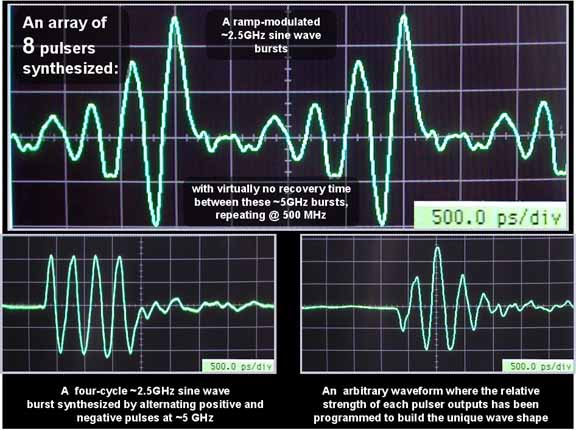
Waveforms demonstrating the unique capabilities of Libove Sample Pulser circuits
How the Libove Sampler Pulser Works
To best appreciate the value of the Libove Sampler Pulser it is essential to understand how it works and then how it can be used. What follows is a description of how the Sampler and Pulser configurations work and three implementations that demonstrate the utility of the circuits. The implementations include Ultra Wide Band (UWB) waveform generation, high speed Analog to Digital conversion and high speed signal processing.
Controlling the Libove Sampler Pulser
Four signals control the output of the Libove Sampler Pulser: Clock, Start, Stop and Analog Input. An output pulse is emitted starting when the Clock falls below the Start signal value. The output pulse is extinguished when the Clock falls below the Stop value. The difference between Start and Stop voltages determines the output pulse width. The amplitude of the output is equal to the amplitude of the Analog Input signal (600millivolt maximum into 25 ohm double-terminated transmission line).
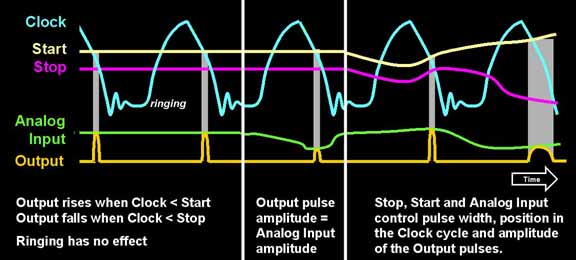
Input/Output for a single Libove Sample Pulser
Ultra Wideband (UWB)
Ultra Wide Band (UWB) applications include synthesis and reception of signals in the <10GHz band. FCC regulation has allocated a band above 3.1 GHz for wireless communication devices using very low power. Arrays of the Libove Sampler Pulser can be used to directly synthesize custom UWB transmissions in the 3.1GHz to 10GHz spectrum. This direct synthesis method has far simpler filtering requirements and is less susceptible to damage or tampering than planned baseband synthesis techniques. Additionally, the pulse shape can be tuned in place (amplitude, position, duration) by means of DC signals to attain the desired transmission characteristics and compensate for imperfect RF elements (antenna, medium, etc.) This unique capability will enable powerful low-cost designs that comply with the FCC allocated band.
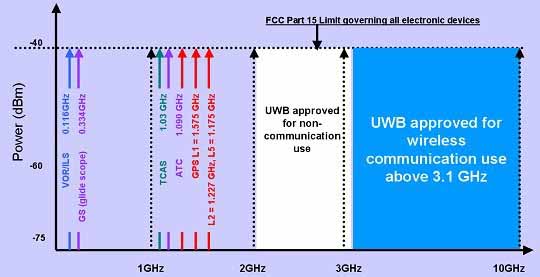
UWB spectrum shown in FCC frequency allocation
The superior operating and matching characteristics of the Libove Sampler Pulser make it ideally suited for Ultra WideBand applications. The combination of the Libove Sampler Pulser’s stability, repetition rate, aperture modulation, noise rejection and scalability make it ideally suited for advanced UWB ASIC applications. A UWB transmitter incorporating the Libove Pulser has the capability to:
- Dynamically synthesize and receive complex signals in a 10 GHz band
- Control Tx spectral signature
- Adapt to changing spectrum conditions, eliminating the need for Tx filters because it is directly band-limited
- Pre-correct antenna Tx/Rx,
- Adapt to changing government regulations because it is field programmable
In short, a Libove Pulser array generates faster and more complex pulse structures at a lower cost than possible with conventional technology. The Libove Sampler Pulser allows the UWB system to dynamically control its spectral signature to adapt to changing spectrum conditions and to mitigate effects such as rain fade. Moreover, a UWB system incorporating the Libove Pulser has the added advantage of being directly band-limited at the point of synthesis and avoids out-of-bound interference with existing spectrum users. Because the Libove Sampler Pulser is programmable, it can even be adapted to changing FCC regulations – saving equipment from early obsolescence.
Ultra Wideband Tailor Made Waveform Generation
Generate tailor made UWB pulse streams with an array of Libove Pulsers and Digital to Analog Converters (DACs). Low speed signals from the DSP control the DACs, each of which generate relatively slow Start, Stop and Analog Input signals. Each Libove Pulser contributes a short pulse. The DACs are set so the Pulser generates only higher frequency components. The combined output waveform contains no lower frequency components <3.1 GHz or >320 psec pulses. This waveform generator architecture is ideally suited for a UWB transmitter and addresses many UWB test and development tool requirements as well.
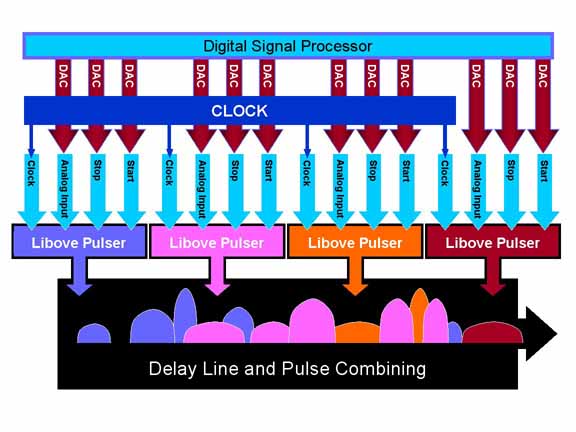
Multiple Libove Pulsers generating a dynamically controlled pulse stream
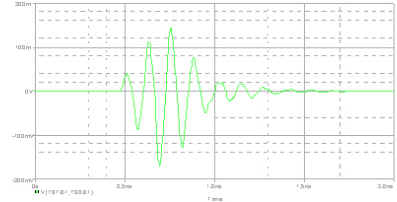
An example output using the above toploogy. Note waveform has a Guassian envelope
The superior operating characteristics of the Furaxa pulser/sampler make it ideally suited for ultra wideband and pulse width modulation applications. The Furaxa pulser/sampler IC enables efficient modulation schemes which significantly enhance the bandwidth efficiency of any UWB system. Schemes such as quadrature pulse amplitude modulation are now possible at significantly higher frequencies than conventional technology previously allowed.
High Speed Analog to Digital Converter
An array of Libove Samplers and lower speed Analog to Digital Converters (ADCs) can be configured as a very high speed ADC. The Analog Input signal is sent through a tapped delay line, so that each Libove Sampler is looking at the same signal somewhat delayed. Between Start and Stop each of the Samplers emits a pulse with amplitude equal to its Analog Input amplitude. Start and Stop are held at fixed DC voltages so a constant sample aperture at a constant rate capture the Analog Input signal precisely at the same moment in each clock cycle. The output pulses are held by sample and hold circuits to be picked off at slower rates by the array of ADCs. An Output from the Libove Sampler can drive a 12 bit ADC. The High Speed ADC shown multiplies the sample rate of each individual ADC by 4 in this example. Where 4 is the number of Sampler/ADC/ Sample & Hold sets. This architecture lends itself to Single Shot Digital Oscilloscope, Waveform Recorders and Automatic Test Equipment applications.
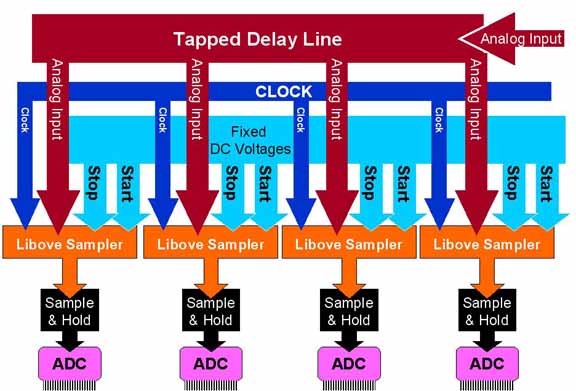
Combining Libove Samplers to perform high-speed ADC
High Speed Signal Processing
An array of Libove Sampler Pulsers multiples the response of today’s fastest DSPs. The operating characteristics of the Libove Sampler Pulser make it an ideal building block in new ICs capable of parallel processing a large number of rapidly-acquired or synthesized samples enabling more complex and accurate real-time synthesis and processing than was formerly possible. New architectures in signal processing, amplification, data separation, equalization, mixing and filtering are now economically feasible.For example, the Libove Sampler Pulser can be used as an element in complex high-speed modulators and demodulators, image reject mixers and frequency doublers. The diagram illustrates a generalized signal processing architecture for a wide variety of frequency mixers and modulators, correlators, microwave amplifiers, filters, Viterbi and other convolutional decoders, and almost any other linear and non-linear signal processing system at high frequencies.
The architecture consists of an input terminal coupled to a string of analog delay lines The outputs of the delay lines, each containing a copy of the input signal delayed by a sequentially increasing amount, are coupled (Analog Input signal) into Libove Sampler. The Output pulses from the Libove Samplers are sent through Sample & Hold circuits then ADC to the DSP. Then the DSP performs the desired signal processing operations on the digitized signal then sending the response through DACs to the array of Libove Pulsers via the Analog Inputs. On the falling edge of the Clock signal, each pulser takes a snapshot of the Analog Input from the DACs.
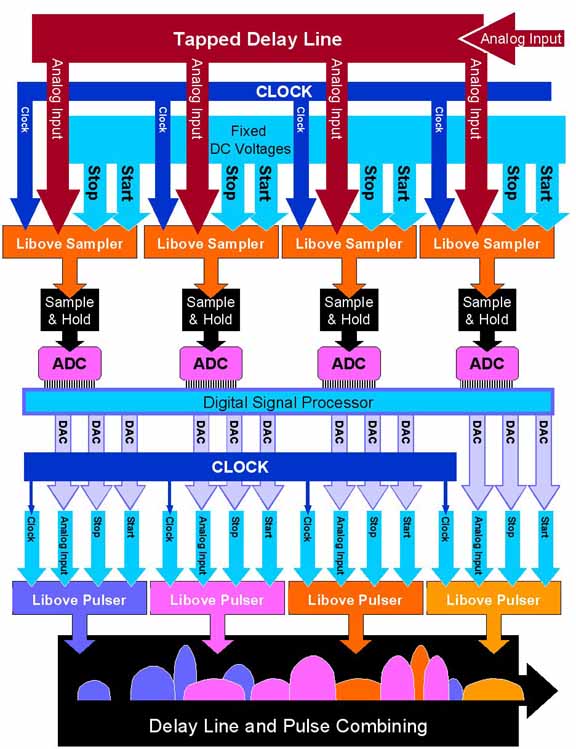
A general signal processing structure using Libove Sampler Pulsers
The Outputs of the Libove Pulsers are combined through a delay network, yielding a continuous response waveform. In this way, the circuit breaks down a continuous input waveform into a sequence of n rapidly acquired time samples, each of which can be processed at a rate that is n times slower, where n is the number of samplers arrayed (n=4 in this diagrams). The response is transformed back into a sequence of n very rapidly changing output samples. Every time the Clock falls a new set of samples are taken, processed, and converted into an output stream as illustrated.
While the concept of taking a rapid sequence of samples, holding them for a period of time, processing them in parallel, and then re-serializing the result of these parallel outputs is not novel. The architecture of the Libove Sampler Pulser makes signal processing practical for much faster signals than formerly possible. For example, conventional microwave image-reject mixers converting an RF signal into a near-baseband signal typically have less than an octave in bandwidth over which they can operate. In contrast, the circuit architecture would produce an advanced image reject mixer with a frequency range of several octaves that could operate at much higher frequencies. Similarly, faster active filters and amplifiers with better linearity and flatter frequency response are now feasible.
Summary
When asked about the Sampler Pulser, Furaxa VP Engineering Steve Chacko said, “This novel circuit architecture offers more precisely shaped sampling apertures and pulses at greater speeds with more stability, better matching and lower power usage and cost than conventional techniques. With this patent, Furaxa establishes a leadership position in advanced signal synthesis and sampling.The circuit architecture has applications in ASICs that require an array of precisely matched ultra-fast pulse generators such as UWB. By building a transmitter with an array of the Libove Pulser Samplers, waveforms without low frequency – out of band – components are transmitted without the need for filtering before transmission. That makes it the ideal choice for UWB oriented ASIC designs.
As the Libove Sampler Pulsers are implemented by faster foundry processes such as InP or pHEMT, the performance characteristics will improve dramatically.”
Evaluation Board, Price & Delivery
The initial Libove Sampler Pulser circuits were rendered in a GaAs MESFET process and functional chips have been evaluated. The waveforms shown were obtained from an array of four of these chips. Technology demonstrations and evaluation boards are available for loan to qualified interested parties. Each evaluation board includes multiple Libove Pulsers. Signals are on SMA connectors. Evaluation requires a >18 GHz bandwidth sampling oscilloscope.
Furaxa Licensing Partners
Furaxa is seeking partners to license the Libove Sampler Pulser technology, and its US Patent 6,433,720, for use in advanced ASIC designs. Furaxa ASIC design expertise is also available. Licenses are available based on exclusivity or non-exclusivity in market segments. Additional information is available by contacting Steve Chacko at (925) 253-2969 or via email: chacko@furaxa.com.